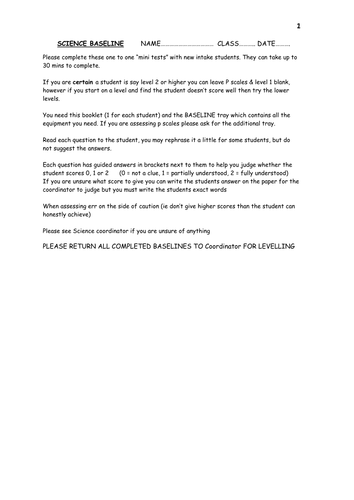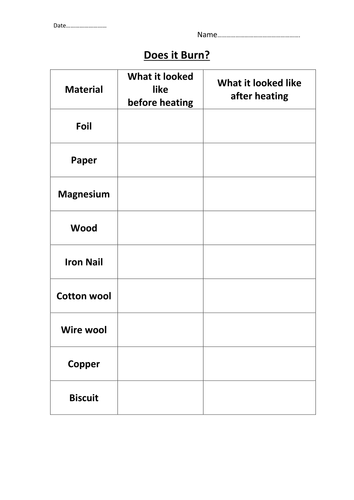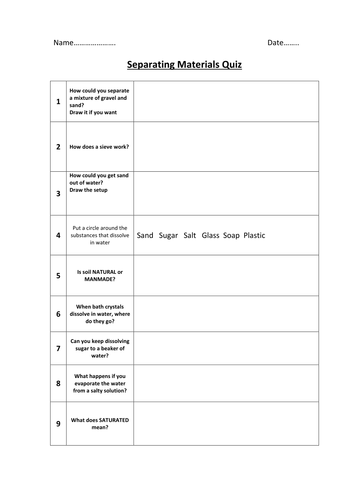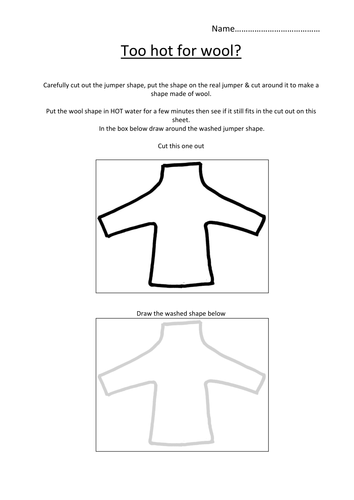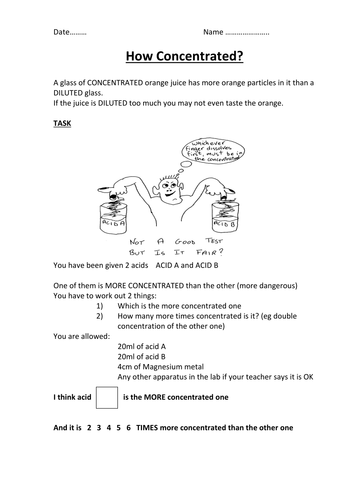
69Uploads
16k+Views
511Downloads
Chemistry

SCIENCE BASELINE assessment from level P4 to 4a (old NC levels)
I have used this assessment with students over the years and modified/improved as time went on.
I believe it to be a good way of assessing students when they are new to the school or even at the end of each year or indeed at any time you wish.
It is based around 4 small assessments for Biology, Chemistry & Physics, so a total of 12 mini-assessments.
Ideally the teacher or assistant spends up to 30 mins (can split the assessment over a few days if you wish but best results have been when the entire assessment is completed at one time) in a ONE TO ONE session.
The teacher/assistant reads the script (this is important as it reduces leading questions and clues to answers), the responses are noted down but in most cases a tick will indicate if the student has understood fully, partially understood or not understood at all.
Minimal resources are needed and are kept in a tray for use at any time. I believe doing or demonstrating science is a beautiful way to engage students, so the assesment uses this.
You will need to source basics like balloons, toy car, rocks etc.
I chose to set up 4 trays so 4 assessments could be completed at the same time (perhaps different classes)
The levels assessed are from P4 up to 4a old levels (which I believe are still useful) you may wish to change the names of the levels to suit your own school.
The script states which resources to use in each question as well as appropriate answers that should be expected for fully, partially and not at all levels of understanding. This allows staff that are not science trained to be able to complete these assessments with the students with relative ease.
Good luck

Acids & Alkalis
This is a tried, tested and improved assesment that has worked well with many students.
The assesment is based on the old NC levels 1 to 5 (subdivided into a,b & c)but you can convert into any level description you need, frankly a staged 1 to 5 indicator is as useful as ever whatever you may wish to call it.
I have devised a sytem which gives you a measure of success: each question can score 0, 1 or 2, if a student scores a 2 then you can say they understand the concept fully, score of 1 they understand partially, 0 means they may have experienced the concept but do not understand it much if at all.
The support sheet can be used as a teaching scheme for staff. Split into 3 columns the first column states what concept is being testsd, 2nd column tells you what is required for a score og 1, 3rd column what is required for a score of 2.
I have used this sytem to calculate a score for students...if they achieve 75% or more then I believe you can say they have achieved that level.
Good luck

Get the salt
Students are given some dirty salt (salt +sand/soil..whatever you wish) I have even simulated urine(orange juice) to reinforce the plight of poor hygeine in some countries.
The sheet takes students through the 3 steps of purifying the salt.
The final step of evaporating the water using evaporating basins can be tricky if the heat is left on too long.....if no bunsens/heat is available you can just leave the solutions to "dry out" naturally..you can get nice crystals forming over a couple of days.
Why not take the students out for fish and chips later on (keeping a sample of your salt to sprinkle on your chips)

Find and sorting materials
Simple worksheet that allows students to invstigate materials and their uses around school (at home for HW).
Students can look at specific objects(chair) and write down what it seems to be from.
Students are also encouraged to look for the material and say what it is used for...so that materials and properties are approached from both ways.
Then the more tricky task of putting materials into groups, students can classify them in their own way..get ready for some unusual classification techniques.
As an extension students can continue with materials/objects of their own choice..this usually introduces the student's own interests into scientific method.

Does it burn?
Lovely activity, not for the faint hearted.
Give students a selection of materials which they examine and describe simply.
They then (with the required H&S) heat the material/object using a bunsen(roaring or yellow...you decide), tongs, observe and describe the material afterwards.
I have done this expt using tea light candles in a classroom, with bench mats and an extra pair of eyes it worked beautifully.
This promotes many aspects of chemical changes, durability, suitability etc etc of materials for specific tasks

Separating materials quiz
Short simple quiz that allows you to judge the understanding and level of your students

Too hot for wool?
A nice activity to show the effect of washing woolen clothes in too hot water.
I would come to school wearing a woolen jumper ready for throwing out.
The worksheet gets the student to cut out a jumper shape as a template to put on my jumper and cut out a real wool jumper shape.
10 to 15 shapes can easily be cut from one of my jumpers (which I continue to wear full of jumper shaped holes) this IS funny
The students heat water in a 250ml beaker to different temps (nice investigation) and "wash" their wool jumper shape for a few mins, then see how it has changed by placing it on the second template

Red & Blue Litmus
Using red & blue litmus to investigate different substances.
Both red & blue results are required for correct results

How Concentrated?
A lovely challenge to get students thinking about what concentration means.
At basic levels the expt can be used to determine which acid is the more concentrated (Mg reacts more quickly)
On the higher level you can use the apparatus suggested to calculate pretty much how much more concentrated one is than the other (determined by you) but calculated by the ratio of the times taken to react equal amounts of Mg

Acids, Alkalis or Neutral 2
A nice colourful worksheet to be filled in as a selection of substances are tested with pH included

Acid, Alkali or Neutral 1
A nice colourful worksheet to be filled in whilst a selection of substances are tested

